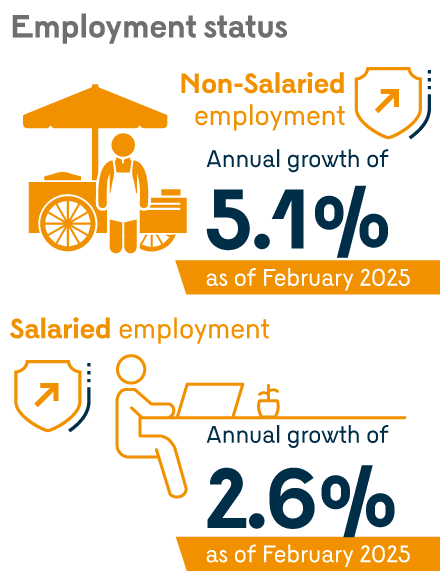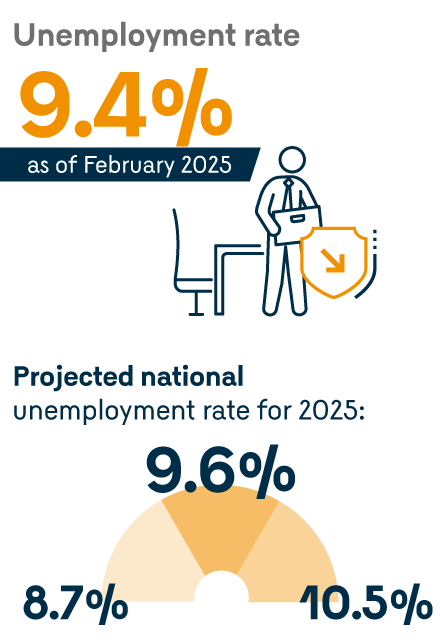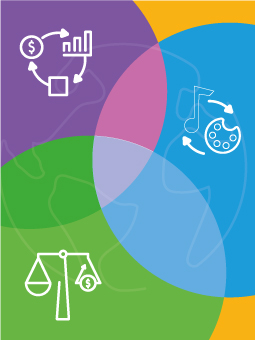Labor Market Report – Employment Growth driven by the Non-Salaried Segment and Analysis of Remote Work in Colombia
The Labor Market Report (RML in Spanish) series is a quarterly publication by the Labor Market Analysis Group (GAMLA, in Spanish) of Banco de la República (the Central Bank of Colombia), a group created in 2017. Opinions and possible errors are the author’s sole responsibility, and its contents do not compromise Banco de la República nor its Board of Directors.
Data from the official household survey in Colombia (GEIH in Spanish) show that, as of February 2025, employment continued to grow at an annual rate of 3.9%. This is primarily attributed to better employment dynamics within rural sectors, which expanded at a 4.9% rate. Regarding the dynamics and effects of remote work, results show that in the post-pandemic period job vacancies for remote positions increased 4.4%. Although there is no evidence that teleworking affects wage increases, it appears to improve the efficiency of job matching in the labor market.
- As of February 2025, employment continued to grow at an annual rate of 3.9%, primarily driven by rural employment, which grew at a 4.9% rate.This has resulted in a 1.4 percentage point (pp) increase in the employment-to-population rate (EPR) and a 1.8 pp rise for rural areas. As a result, EPRs stand at 58.4% and 57%, respectively. In urban areas, the EPR increased at a slower rate (0.9 pp) and stands at 59.8%.

- Recent employment growth has been primarily driven by the stronger performance of the non-salaried segment.
- Between February 2024 and 2025, non-salaried employment grew by 5.1%, while salaried employment increased by 2.6%.
- The sectors contributing most to annual employment growth are commerce and accommodation, while professional activities, recreation, and other services showed the greatest negative contribution.
- In line with lower performance in formal employment, job vacancy rates continue to decline, approaching pre-pandemic levels.

- As of February 2025, the national unemployment rate (UR) decreased by 1.1 pp, reaching 9.4%.
- In the Colombian main twenty-three cities, the UR also fell and stood at 9.2%, while in other municipalities and rural areas it stood at 9.7%.
- Despite a slowdown in job vacancy indicators, the relationship between the unemployment rate and the vacancy rate, also known as the Beveridge curve, exhibits a still tight labor market, particularly due to the recent decline in the unemployment rate.
- Median real incomes grew significantly between 2024 and 2025, especially among the salaried segment and people without higher education.
- Considering the gross domestic product (GDP) projections published in the Monetary Policy Report (MPR, April 2025), the latest unemployment rate forecast suggests relative stability throughout 2025.
- The urban average unemployment rate is expected to range between 8.3% and 10.1%, with 9.2% as the most likely value for 2025. For the national aggregate, the projected range is between 8.7% and 10.5%, with 9.6% as the most likely figure.

- Regarding the dynamics and effects of remote work on wage variations and labor market efficiency, results exhibit that job vacancies for teleworking increased by 4.4% in the post-pandemic period.
- There is no causal evidence that remote work vacancies offer higher wages, once the estimation biases are corrected.
- On the other hand, the evidence presented in this Report suggests that the increase in remote work may have improved the efficiency of job matching between vacancies and unemployed workers.

































































